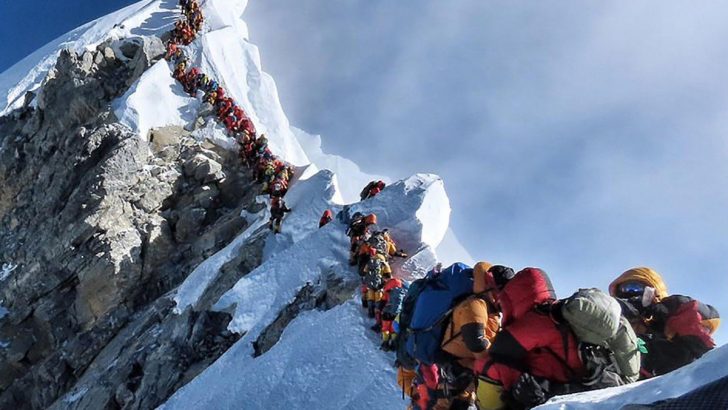Mainly About Books
by the books editor
I have been wondering over recent days what Achille Ratti, later in life Pope Pius XI, would have thought of the recent images of toe-to-heel climbers, some 300 of them, ascending Mount Everest to take a selfie at the summit.
In the course of this insane “bucket-list of awesome things to do before you die” pseudo-adventure, into an area rightly called a “death zone”, some 11 people have died over the last month.
In his younger and heartier days, Ratti (born in 1857) was an energetic Alpinist among the mountains between northern Italy and Switzerland. He was said to have ‘conquered’ something like a hundred previously unclimbed peaks. Such was his renown that he published a book about his adventures, Climbs on Alpine Peaks (1923).
He belonged to the pioneering ranks of mountain climbers, not quite the first generation, but certainly the second. Such an activity was then a minority sport, the dangers of which were recognised. It was no safe outing for overweight tourists, as today.
Ratti was an experienced athlete. He knew what he was doing. He also knew when to stop. By the time he was elected Pope he had given up his scrambles in the Alps.
Many of those who are taken up Everest today do not know what they are doing; they are quite untrained, some of them only seeing their equipment for the first time at the base camp. They bask in the conceit that people having fun will not be allowed to die. The trips cost on average about $60,000; $130,000 for the de luxe service. If anything happens to them they will, of course, in the now universal American manner, sue the company.
Abode of the gods
In Nepal, Tibet and China, respect for the majesty of natural creation, prevented the local people from climbing these peaks, though what happens now is more akin to assault and battery.
But what can one expect. Every summer we see even Irish charities organising ‘fund-raising’ climbs of the Ruwenzori, runs in the Andes, Machu Picchu challenges – that sort of thing. With little or no consideration for what this intrusion means to the environment of these places.
But as the great French criminologists Dr Locard taught, “every contact leaves a mark”. An ancient Chinese punishment was death by a thousand cuts.
We seem incapable of respecting and enjoying things for what they are, from a distance. This is not a new problem. The Jesuit poet Gerard Manley Hopkins wrote: “Generations have trod, have trod, have trod; / And all is seared with trade; bleared, smeared with toil; / And wears man’s smudge and shares man’s smell…”
It has become a truism that humanity itself is destroying the world around us, “our common home”.
There ought to be places where no-one should go. The incessant urge to travel, even if only on a monster cruise liner with 6,000 passengers – the population of Ballinasloe on one ship – ought to end.
Some places have been so destroyed nobody wants go there. One of these places is Chernobyl”
As for Everest, all around the foot of the mountain can be seen the rubbish heaps of bottles and tin cans left behind by previous expeditions and weekend outings. Pictures of these are never published in the papers. “That’s not what people want to see,” editors always say – let’s have a cute panda instead.
Yet ironically, some places have been so destroyed nobody wants go there.
One of these places is Chernobyl, everyone’s short hand for the nearly ultimate disaster that kills at once, and goes on killing – for radiation sickness hangs around a long time. Yet the district is strangely enough teeming with renewed wild life, creatures unharried by human intrusion.
And so, thank God, as Hopkins reminds us, and Achille Ratti would have heartily endorsed, “…for all this, nature is never spent;/ There lives the dearest freshness deep down things …”
[Achille Ratti: Il prete alpinista che diventò Papa, by Domenico Flavio Ronzoni (Bellevita, €15.00, 2009) is still available.]


 Peter Costello
Peter Costello This handout photo taken on May 22, 2019 and released by climber Nirmal Purja's Project Possible expedition shows heavy traffic of mountain climbers lining up to stand at the summit of Mount Everest. Photo: AFP
This handout photo taken on May 22, 2019 and released by climber Nirmal Purja's Project Possible expedition shows heavy traffic of mountain climbers lining up to stand at the summit of Mount Everest. Photo: AFP 